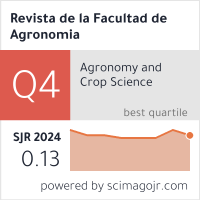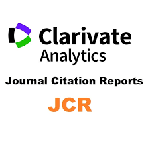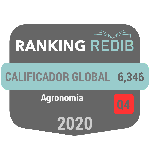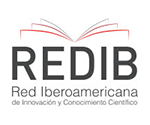Potential of Citrullus lanatus seeds as a natural coagulant in drinking water treatment
Abstract
Natural coagulants have received significant attention due to their biodegradable nature, cost-effectiveness, and abundance of sources. The objective of the research was to analyze the efficiency of Citrullus lanatus seeds treating synthetic waters with three levels of initial turbidity (13, 75, and 200 NTU), applying four rapid mixing times (1, 2, 4, and 5 min) in the purification process. The coagulant was prepared with 5 g of the seed previously ground, sieved, defatted, and diluted in a volume of 1 L of distilled water. Jar tests were performed using doses of 50, 70, 90, 100, 150, 200, 250, 300, 400, and 500 mg.L-1 using true color and turbidity as control parameters. The coagulation was performed at a speed of 100 rpm, while flocculation lasted 20 minutes at 30 rpm, and the resting phase was 30 minutes. It was obtained that the optimal doses of C. lanatus in the treatment process were 50, 150, and 300 mg. L-1 for waters with 13, 75 and 200 NTU, respectively, obtaining the highest percentages of turbidity removal (96.6%) and true color (94.4%) in water with 75 NTU. Furthermore, it was concluded that increasing the time in the rapid mixing phase caused an increase in the levels of turbidity and true color; being the time of 2 min the one that generated water that meet the values desired by the current Venezuelan drinking water regulations, which contemplates 1 NTU for turbidity and 5 UC Pt-Co for true color.
Downloads
References
Adugna, A. y Gebresilasie, N. (2018). Aloe steudneri gel as natural flocculant for textile wastewater treatment. Water practice and technology, 13(3), 495-504. https://doi.org/10.2166/wpt.2018.062.
Association of Official Analytical Chemists [AOAC]. (2005). Official method of Analysis. 18th Edition, Association of Officiating Analytical Chemists, Washington DC, Method 935.14 and 992.24.
Arciniega, M., Ávila, J. y Hernández P. (2024). Remoción de sólidos totales en agua mediante coagulantes naturales: Semillas de linaza, chía y zaragatona. Producción Agropecuaria y Desarrollo Sostenible, 12(1), 115-129. https://doi.org/10.5377/payds.v12i1.17420
Arias, J., Vergara, J., Arias, E., Gould, A. y Gazabon, D. (2020). Evaluation of low-cost alternatives for water purification in the stilt house villages of Santa Marta's Cienaga Grande. Heliyon, 6(1), e03062. https://doi.org/10.1016/j.heliyon.2019.e03062
Awad, M., Wang, H. y Li, F. (2013). Preliminary study on the combined use of Moringa seed extract and PAC for water treatment. Journal of recent science, 2(8), 52-55.
Balbinoti, J., Jorge, R., Santos, R., Balbinoti, T., De Almeida, L. y De Jesus, F. (2024). Treatment of low-turbidity water by coagulation combining Moringa oleifera Lam and polyaluminium chloride (PAC). Journal of Environmental Chemical Engineering, 12(1), 111624. https://doi.org/10.1016/j.jece.2023.111624.
Bina, B., Mehdinejad, M., Nikaeen, M. y Movahedian, H. (2009). Effectiveness of chitosan as natural coagulant aid in treating turbid waters. Iranian Journal of Environmental Health Science and Engineering., 6(4):247-252.
Carrasquero, S., Martínez, M., Castro, M., Díaz, A. y Colina, G. (2019). Remoción de turbidez usando semillas de Tamarindus indica como coagulante en la potabilización de aguas. Bases de la ciencia, 4(1), 19-44.
Carrasquero, S., Lozano, Y., García, M., Camacho, M., Rincón, A. y Mas y Rubí, M. (2015). Eficiencia de las semillas de durazno (Prunus persica) como coagulante en la potabilización de aguas. Boletín del Centro de Investigaciones Biológicas, 49(3), 239-25.
Comisión Venezolana de Normas Industriales [COVENIN]. (1980). Norma venezolana. Productos cereales y leguminosos. Determinación de grasas. COVENIN No. 1553-80. Caracas, Venezuela.
COVENIN (1981a). Norma venezolana. Productos cereales y leguminosos. Determinación de cenizas. COVENIN No. 1783-81. Caracas, Venezuela.
COVENIN (1981b). Norma venezolana. Productos cereales y leguminosos. Determinación de grasas. COVENIN No. 1785-81. Caracas, Venezuela.
Dahasahastra, V., Balasundaram, K. y Latkar, M. (2022). Turbidity removal from synthetic turbid water using coagulant recovered from water treatment sludge: A potential method to recycle and conserve aluminium. Hydrometallurgy, 213, e105939. https://doi.org/10.1016/j.hydromet.2022.105939.
Fondo de las Naciones Unidas para la Infancia [UNICEF] (2014). Agua, saneamiento e higiene. https://www.unicef.org/es/agua-saneamiento-higiene.
Gaceta Oficial de la República de Venezuela [GORBV] (1998). Normas sanitarias de calidad del agua potable. No. 36.395, de fecha 13 de febrero de 1998. Caracas, Venezuela.
Junho, A., Dos Santos, I. y Silva, A. (2021). Treatment of wastewater from the dairy industry with Moringa oleifera using two different methods, Research, Society and Development, 10, e21710716514, https://doi.org/10.33448/rsd-v10i7.16514.
Lipps, W. C.; Braun-Howland, E. B y Baxter, T. E. (Eds.). (2022) Standard Methods for the Examination of Water and Wastewater, 24th ed. Washington DC: APHA Press.
Mandizvo, T., Odindo, A. y Mashilo, J. (2022). Nutrient composition and physical properties of citron watermelon (Citrullus lanatus var. citroides (L.H. Bailey) Mansf. ex Greb.) seeds are related to seed coat visual appearance. South African journal of botany, 145, 405-419. https://doi.org/10.1016/j.sajb.2022.02.015.
Mishra, R. (2023). Disponibilidad de agua dulce y su desafío global. British Journal of Multidisciplinary and Advanced Studies, 4(3), 1–78.
Okuda, T., Baes, W., Nishijima, N. y Okada, M. (2001). Coagulation mechanism of salt solution extracted active component in Moringa oleifera seeds. Water Research 35(3), 830-834. https://doi.org/10.1016/s0043-1354(00)00296-7.
Organización Mundial de la Salud y Fondo de las Naciones Unidas para la Infancia [OMS-UNICEF] (2015). Informe en materias de saneamiento y agua potable. Informe de actualización y evaluación del ODM. Ginebra, Suiza. https://www.unwater.org/sites/default/files/app/uploads/2020/04/WHOUNICEF-Joint-Monitoring-Program-for-Water-Supply-and-Sanitation-JMP- %E2 %80 %93-2015-Update_ESP.pdf
Pérez, E. (2016). Control de calidad en aguas para consumo humano en la región occidental de Costa Rica. Tecnología en Marcha, 29(3), 3-14. http://dx.doi.org/tm.v29i3.2884
Roy, C., Sati, V. P., Biswas, A. y Kumar, S. (2023). Status of drinking water, sanitation facilities, and hygiene in West Bengal: evidence from the National Family Health Survey of India (NFHS), 2019–2021. Journal of water sanitation and hygiene for development, 13(1), 50-62. https://doi.org/10.2166/washdev.2023.228.
Salinas, D. La Cruz, L., Zambrano, L, Rodríguez, J. Sanoja, K. Luque, R., Fernández, K., Gómez, Y. y Baquerizo, R. (2023). Evaluation of a continuous flow electrocoagulation reactor for turbidity removal from surface water. Process Safety and Environmental Protection, 198, 478-488. https://doi.org/10.1016/j.cherd.2023.08.049
Sathish S., Vikram, S. y Suraj, R. (2018). Effectiveness of turbidity removal from synthetic and tannery wastewater by using seeds of a natural coagulant Citrullus lanatus. Nature Environment and Pollution Technology: An International Quarterly Scientific Journal, 17(2), 551-553. https://www.neptjournal.com/upload-images/NL-64-30-(28)B-3487.pdf
Ugwu, N., Umuokoro, A., Echiegu, E., Ugwuishiwu, B. y Enweremadu, C. (2017). Comparative study of the use of natural and artificial coagulants for the treatment of sullage (domestic wastewater). Cogent Engineering, 4(1), 1-13. https://doi.org/10.1080/23311916.2017.1365676
Copyright (c) 2025 Sedolfo Jose Carrasquero Ferrer, Altamira Rosa Díaz Montiel, María Carolina Pire Sierra

This work is licensed under a Creative Commons Attribution-NonCommercial-ShareAlike 4.0 International License.


















